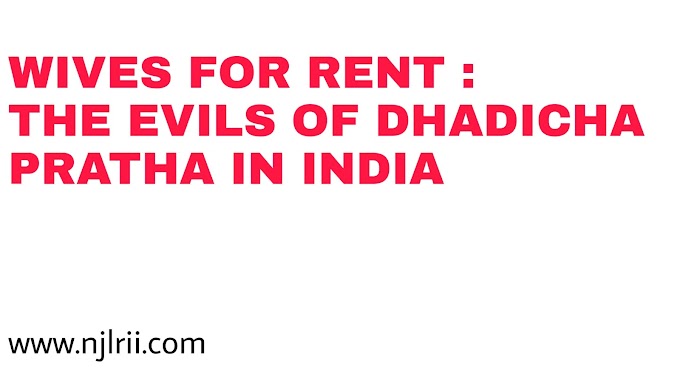ABSTRACT:
The concept of gender justice heralds equal treatment ensuring equal opportunity and rights to every human being irrespective of their gender. But the real scenario seems to be different. Most of the laws regarding sexual harassment and particularly legal provisions for rape are woman-centric and assume men as the only perpetrator to commit such heinous crimes. Statistics say that it is not just women who are victims of harassment physical or mental, but it is also men who often fall prey to such inhuman crimes. It is that crimes against a man are not talked about in our country as we talk and spread awareness about crimes against women. More often men are subjected to sexual harassment, but due to fear of shame from society, these incidents remain unheard. Thus justice is never delivered. So the question arises whether the Indian legal system is efficient enough in equally addressing the crimes against men and women or whether there lies a void in the matters concerning men.
KEYWORDS:
Gender Justice, male, female, rights, opportunity, sexual harassment, rape, society.
INTRODUCTION:
Gender Justice can be regarded as the fair treatment towards every gender existing in a society thereby ensuring equal rights and opportunities to all.
The constitution of India begins with the Preamble saying "…Justice- social, economic and political" and "…Equality of status and opportunity" for all, which indeed upholds the idea of gender equality. Moving on to Article 14, it guarantees equality before the law, emphasizing gender equality in all legal and state actions. Article 15 (1) forbids discrimination solely based on sex. Article 15 (3) enables affirmative actions for the benefit of women and children. This article especially talks about the female gender and the children. But the word 'gender justice' is concerned with all genders and does not intend to separate human beings based on their gender to make laws. Hence, it can be said that Article 15(3) essentially bows towards "feminism" and not gender justice. Not only the constitutional provisions like Section 498A, 304B, 376, and 494 of the Indian Penal Code, which are focused on empowering and safeguarding women from all sorts of harassment physical or mental, have eventually been a source of perpetuating inequalities between men and women. Very often, women tend to misuse the legal provisions in order to fulfill personal grudges against their husbands and their family members too. Several families have been ruined due to the false accusation of the wife against her husband and his family. Again Article 16 ensures equality of opportunity in public employment, irrespective of gender. This Article is, in fact, a very good example of a provision ensuring gender equality since it does not favor any one gender but ensures equal treatment to one and all.
In addition to this, Article 39 (a) and (d) enshrines the principle of equal pay for equal work and ensures equal means of livelihood for both genders. Hence, the main agenda of gender justice is to develop equality among them as "equal human beings" and not demarcate a boundary between the genders. But now, it is also true that [of the two genders, since the location of women is disadvantageous compared to the other, any talk on gender issues focuses more on women, although men too are victims of image stereotype.]
Hence if the world focuses more on gender balance rather than gender equality, the world would be a better place to dwell for every gender.
SEXUAL HARASSMENT: A GROUND REALITY
Article 14 of the constitution of India, heralds that the state shall not deny equality before the law to any person irrespective of gender, and also every person shall be entitled to equal protection of the laws within the territory of India. Here a question arises as to whether the Indian laws equally protect every gender.
Section 354A of the Indian Penal Code talks about sexual harassment and its punishment. The section begins with “A man committing any of the following…” This denotes that the said provision of the Indian Penal Code is not a gender-neutral one. This results into the conclusion that the Indian legal system believes that only a woman can fall prey to sexual harassment, not a man. As a matter of fact, the law does not even consider a male child as a victim. Section 354C of the Indian Penal Code which deals with voyeurism expressly denotes that a man is the perpetrator and the woman is the victim. Then does that mean an act wherein a woman is watching and capturing the image of a man engaged in a private act does not amount to an offense? This is where the Indian Penal Code lacks gender-neutral provisions; this is where the Indian Legal System fails to ensure justice for men in particular. The same issue is faced in the case of section 354D also, wherein a man is considered as the perpetrator and the woman a victim. We need to understand that the modesty of a man matters just like the modesty of a woman; just like a 'no' from a woman means 'no', likewise a ‘no’ from a man too should be respected. Again section 375 of the Indian Penal Code initiates the definition of rape with the words “a man is said to commit “rape” if he…” so it is a question as to why all men are targeted or considered to be the perpetrators and not a victim.
A shocking incident was reported in Jalandhar, Punjab in November 2022. A man who is a leather factory worker alleged that he was kidnapped by four girls and thereafter gang-raped and dumped in an isolated place when the Intelligent Department of Punjab Police initiated a suo moto investigation into the matter. The man also said that the girls threw some chemicals in his eyes after which he lost consciousness and was later drugged and sexually assaulted. This unfortunate incident serves as an example of the fact that men are also not safe. Maybe the number of such incidents is far less than that concerning women, but crime has no gender; it must be addressed as soon as it is committed and also we should work towards the goal of a crime-free India without considering the gender of a person while doing so.
So if a man is being sexually harassed, there is no dedicated legal provision in India to safeguard the rights of the male victim. Countries like Denmark, UK, and Australia have, to some extent realized this problem and have eventually proposed and accepted gender-neutral laws.
As per the statistics, 14% of the reported rapes involve men or boys, and that 1 in 6 reported sexual assaults is against a boy. In these cases, offenders involve men and women. Just like sexual violence against a woman, sexual harassment against a man is motivated by the desire to dominate and use sex as a weapon against the victim. Again the agony and the societal scrutiny faced by a male victim is equivalent to that of a woman. It is even easier for a woman these days to raise her voice against sexual harassment towards her. But it becomes really hard for a man to come out as a victim due to societal pressure and stigma. Most of the men just accept the torture in silence in fear of the shame and hatred they would earn from society. This would in fact lead the cruel society to question the victim’s manliness. Even today we don't address the issue of sexual violence against men as we do in the case of a woman. Most of the stories of sexual harassment against men remain unheard. Moreover, the media attention that a female victim gets in today's society is much more than that of a male victim. Hence gender gender-neutral laws are the dire need of the hour.






